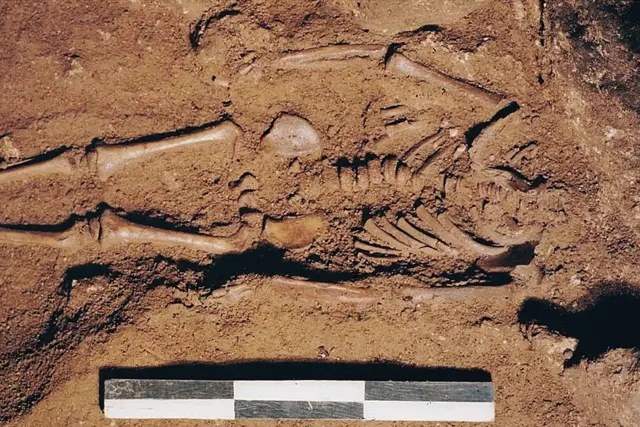The infant’s burial was discovered during the excavations in the Grotta delle Mura site
(Image: Mauro Calattini / Nature Communications)
An international study led by researchers from the University of Bologna, the University of Florence and the University of Siena has accurately reconstructed the development and biological characteristics of an infant who lived in Southern Italy about 17,000 years ago – during the Upper Palaeolithic – and who died when he was only 16 months old. The results, published in Nature Communications, provide an exceptional testimony to the early stages of life and the settling of Southern Italy during the late Upper Palaeolithic.
The investigation focused on some skeletal remains found in the Grotta delle Mura archaeological site, close to Monopoli (Apulia), under the direction of Mauro Calattini, professor at the University of Siena. The finds – among the few well preserved infant skeletons from Upper Palaeolithic – were analysed combining traditional anthropological studies with palaeogenomics, dental palaeohistology, spatially-resolved geochemical analyses and radiocarbon dating.
‘This pioneering study, which combines different analytical techniques, has provided a new vision of the growth and living conditions of an infant who lived in a key phase in the settlement of the Italian peninsula’, says Stefano Benazzi, professor of Physical Anthropology at the Department of Cultural Heritage of the University of Bologna, who was among the coordinators of the study. ‘This is a pivotal step for the understanding of the early stages of life in the Upper Palaeolithic, as it allowed researchers to gather information on his mother and the hunter-gatherer groups of that time’.
Using a few milligrams of bone dust taken from the petrous bone - a portion of the temporal bone known for its excellent DNA preservation, even in such ancient remains – the researchers managed to almost fully reconstruct the genome of the infant: it is the oldest in Italy.
‘The genes suggest that the infant, a male, had blue eyes, ebony skin and curly, dark hair: a mix of traits fairly frequent in the populations of Central and South-Western Europe of the time’, explains Alessandra Modi, from the University of Florence, co-author of the research together with Owen A. Higgins from the University of Bologna. ‘In addition, the genetic analysis has highlighted a close kinship between the parents of the infant – probably first-degree cousins. This phenomenon was rarely observed in the Palaeolithic, but became more common during the Neolithic’.
Furthermore, the study of dental development, carried out starting from thin sections of two teeth, has revealed physiological stress events during the infant’s life.
‘Analyses have revealed a development slightly more premature than the average of modern European populations, as well as at least nine physiological stress events, three of which happened during the intrauterine life of the infant’, explains Owen A. Higgins, from the University of Bologna. ‘The presence of a high number of stress markers is consistent with the genetic results, which suggest the infant probably suffered from hypertrophic cardiomyopathy, a congenital cardiac disease associated with sudden death’.
All these elements contribute to enriching our understanding of the social and biological dynamics of the Upper Palaeolitic and highlight the importance of the Italian peninsula as a crossroads for the intersection of different hunter-gatherer groups during a key phase of human history.
‘Integrating these data allowed us to accurately reconstruct the biological history of the infant, highlighting both the development during early childhood and the possible causes of his premature death’, states David Caramelli, professor of Anthropology at the University of Florence and among the coordinators of the study. ‘In addition, the investigation led to the reconstruction of the oldest genome of Italy. This has revealed significant changes in the population of Southern Italy towards the end of the Last Glacial Maximum with the arrival of groups coming from the Balkans, who colonised Italy starting from the north-east and then heading towards more southern regions of the peninsula’.
The study was published in the journal Nature Communications under the title ‘Life history and ancestry of the late Upper Palaeolithic infant from Grotta delle Mura, Italy’. Several professors from the University of Bologna participated: Owen Alexander Higgins, Federico Lugli, Antonino Vazzana, Matteo Romandini, Eugenio Bortolini, Sahra Talamo, Luca Bondioli, Stefano Benazzi.

